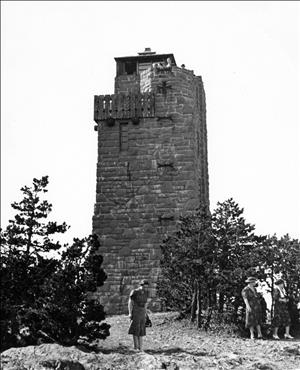In August 1935, 28 men from the 4768th Company of the Civilian Conservation Corps (CCC) begin constructing a stone observation tower atop 2,409-foot Mount Constitution in Moran State Park on Orcas Island. Designed by noted Seattle architect Ellsworth Storey (1879-1960), the tower is the literal and figurative high point of eight years of work by crews from the CCC's Camp Moran. Between 1933 and 1941, the CCC men build miles of trails, many buildings, and numerous other improvements in Moran State Park, which was donated to the state in 1921 by former Seattle mayor and shipbuilder Robert Moran (1857-1943).
Moran State Park
Mount Constitution is the highest point in San Juan County. When Robert Moran sold Moran Brothers Shipyard, which he had built into one of the Northwest's largest shipbuilders, and retired in 1906 at the age of 49, he moved to Orcas Island. There he began acquiring vast tracts of land near the mansion he built and named Rosario. He eventually accumulated 7,800 acres, which included forests, several mountain lakes, and all of Mount Constitution, whose summit commands spectacular views of the entire San Juan archipelago, Vancouver Island, the Olympic Peninsula, and Mount Baker and the Cascade Range.
As early as 1911, Moran attempted to donate some of his land around Mount Constitution to the state for a park named for him. At the time, there was no state body that could accept or operate a park. The state legislature first created a Board of Park Commissioners in 1913, but it had neither guidelines nor funding. Not until 1921, after enactment of new park legislation, did the board, renamed the State Parks Committee, accept Moran's gift of more than 2,700 acres, over the objections of Governor Louis F. Hart (1862-1929). The legislature still did not provide funding to maintain parks, so Moran spent his own money to build roads, trails, bridges, and concrete entrance arches in the new park.
CCC Camp Moran
As with many state and federal parks across the country, much of Moran State Park's infrastructure was eventually constructed by the CCC. Established in 1933, the Civilian Conservation Corps was one of the first and most popular of the New Deal programs created by President Franklin D. Roosevelt (1881-1945) to combat the Depression. It provided employment for millions of young men while constructing important public projects -- parks, campgrounds, dams, bridges, roads, observation towers, and more -- in all 48 states and Alaska, Hawaii, Puerto Rico and the Virgin Islands. Enrollees -- unmarried young men from families on relief -- lived in military-type camps supervised by regular and reserve Army officers and worked on projects organized by the Agriculture and Interior departments.
Camp Moran opened near Moran State Park's Cascade Lake in June 1933. Within a year, crews from Illinois, Minnesota, Arkansas, New York, Missouri, and Kansas had built 10 miles of new trails with 12 bridges and seven buildings including the ranger station, improved existing trails and roads, and surveyed and cleared a fire lane around the entire park boundary. Outside work hours, the CCC "boys" participated in camp sports programs and classes, explored Orcas Island, and socialized with young women from the island at community dances and other events. Over the next seven years, the CCC worked on many other projects, the most prominent being the observation tower on the summit of Mount Constitution.
Building the Tower
The sandstone tower was designed by Seattle architect Ellsworth Storey, who was noted for his use of local Northwest materials. The rectangular tower, tapering slightly toward the top, holds both a fire lookout and an observation platform for visitors. It features thick stone walls pierced by slit windows, heavy wooden doors, wrought iron work, and a carved balustrade around the observation platform.
Working under Storey's supervision, the CCC's 4768th Company, composed of men who came to Camp Moran from Fort Snelling, Minnesota, did the stone and iron work entirely by hand. Eight men cut a thousand tons of native sandstone from a quarry on the North Shore of Orcas. Starting in August 1935, a crew of 28 spent more than a year constructing the tower. Work was suspended for a month in January 1936, because of the intense cold and high winds. The "topping out" -- placement of the final beam at the structure's highest point -- was celebrated on July 7, 1936, and the tower was completed later that year.
The tower was placed on the National Register of Historic Places in 1974. Restoration work was conducted in 2003 and 2004 under the supervision of local contractor Rolf Eriksen. Some CCC veterans who had worked at Camp Moran attended a rededication in May 2004. The tower and its sweeping views remain the top attraction at one of the state's most popular parks.

